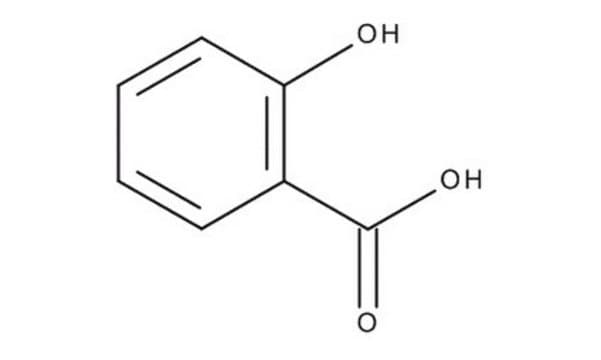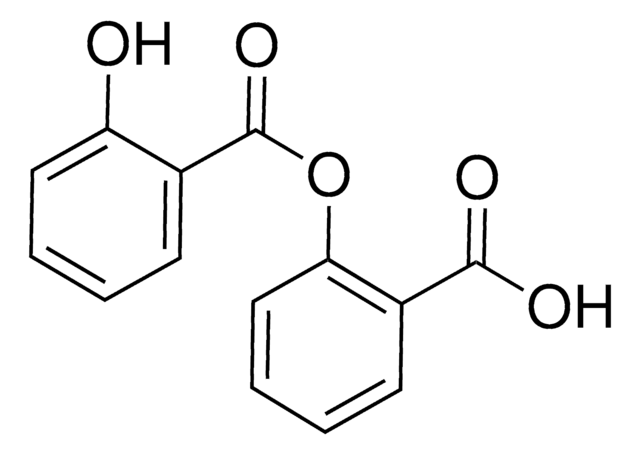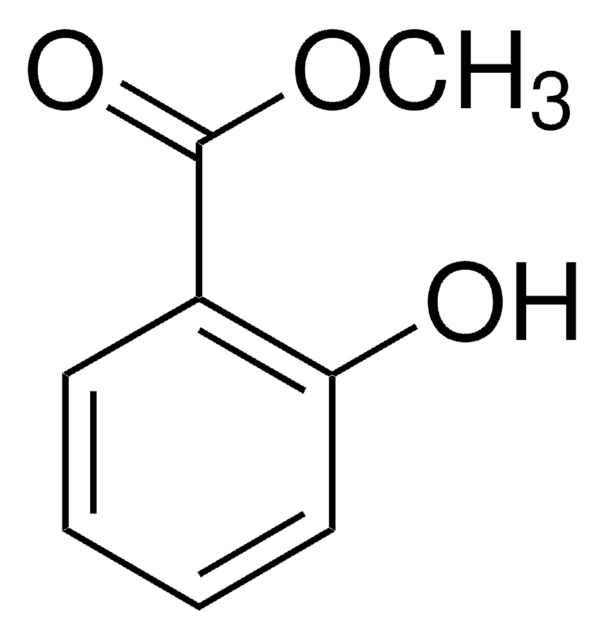PHR1013
Salicylic acid
Pharmaceutical Secondary Standard; Certified Reference Material
Synonyme(s) :
2-Hydroxybenzoic acid
About This Item
Produits recommandés
Qualité
certified reference material
pharmaceutical secondary standard
Niveau de qualité
Agence
traceable to BP 775
traceable to Ph. Eur. S020000
traceable to USP 1609002
Densité de vapeur
4.8 (vs air)
Pression de vapeur
1 mmHg ( 114 °C)
Famille d'API
salicylic acid
CofA (certificat d'analyse)
current certificate can be downloaded
Technique(s)
HPLC: suitable
gas chromatography (GC): suitable
Point d'ébullition
211 °C (lit.)
Pf
158-161 °C (lit.)
Application(s)
pharmaceutical (small molecule)
Format
neat
Température de stockage
2-30°C
Chaîne SMILES
OC(=O)c1ccccc1O
InChI
1S/C7H6O3/c8-6-4-2-1-3-5(6)7(9)10/h1-4,8H,(H,9,10)
Clé InChI
YGSDEFSMJLZEOE-UHFFFAOYSA-N
Vous recherchez des produits similaires ? Visite Guide de comparaison des produits
Description générale
Pharmaceutical secondary standards for application in quality control, provide pharma laboratories and manufacturers with a convenient and cost-effective alternative to the preparation of in-house working standards.
Application
Remarque sur l'analyse
Autres remarques
Note de bas de page
Produits recommandés
Produit(s) apparenté(s)
Mention d'avertissement
Danger
Mentions de danger
Conseils de prudence
Classification des risques
Acute Tox. 4 Oral - Eye Dam. 1 - Repr. 2
Code de la classe de stockage
11 - Combustible Solids
Classe de danger pour l'eau (WGK)
WGK 1
Point d'éclair (°F)
314.6 °F - closed cup
Point d'éclair (°C)
157 °C - closed cup
Faites votre choix parmi les versions les plus récentes :
Déjà en possession de ce produit ?
Retrouvez la documentation relative aux produits que vous avez récemment achetés dans la Bibliothèque de documents.
Les clients ont également consulté
Protocoles
Separation of Acetylsalicylic acid, analytical standard; Salicylic acid, BioXtra, ≥99.0%
Separation of Salicylic acid, meets analytical specification of Ph. Eur., BP, USP, 99.5-100.5% (calc. to the dried substance); Acetylsalicylic acid, purum, ≥99.0% (HPLC)
Separation of 4-Hydroxybenzoic acid; Acetylsalicylic acid; Benzoic acid; Salicylic acid; Ethyl 4-hydroxybenzoate
Notre équipe de scientifiques dispose d'une expérience dans tous les secteurs de la recherche, notamment en sciences de la vie, science des matériaux, synthèse chimique, chromatographie, analyse et dans de nombreux autres domaines..
Contacter notre Service technique












